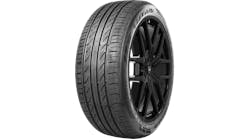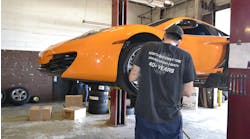The 2015 San Marino and Rimini Grand Prix was subjected to variable weather resulting in almost the whole field changing bikes twice over the twenty-eight lap contest.
In the end, Repsol Honda Team’s Marc Marquez won the race ahead of Monster Yamaha Tech 3’s Bradley Smith in second place, and Marc VDS rider Scott Redding who claimed a maiden MotoGP podium by finishing in third place.
Sunday’s race started in dry conditions with light rain falling which soon intensified, creating wet conditions at which time the majority of riders swapped to bikes fitted with wet tires. The rain soon abated, resulting in a dry line on the circuit at which time slick tires became the preferred option which saw the riders undertake another bike swap. Despite the variable conditions Jorge Lorenzo set a new Misano Circuit Record Lap (1'33.273) on lap 4 of the race, with the Spaniard also setting a new Circuit Best Record (1'32.146) during qualifying on Saturday.
Q&A with Masao Azuma – Chief Engineer, Bridgestone Motorcycle Tire Development Department
The big talking point at Misano last weekend was the new tarmac. How did your tire allocation at this circuit perform over the weekend, and was the decision to bring two symmetric rear slicks justified?
“Traditionally at Misano we usually offer asymmetric rear tires, but due to the new tarmac and the improved performance of the open class bikes compared to last year, we made some changes to the tire allocation this year. The soft symmetric rear slick was offered as given the changes since last year, we needed more durability on the left shoulder of the rear tire but still wanted to offer an option with soft compound rubber on the right shoulder. So instead of an asymmetric soft rear slick with extra-soft rubber on the left shoulder and soft rubber on the right, we decided to provide the symmetric soft rear slick at Misano this year. For the symmetric hard option, even though we had the new tarmac to contend we actually decided to make the right shoulder of this option softer than last year to make it a more attractive race option. I think if track temperatures were close to 50°C on race day some riders would have selected this option for the race as it proved to be quite consistent, with better durability on the left shoulder compared to the asymmetric medium rear. The decision to offer two symmetric rear slicks was based on data we received during private testing and given how our tires performed at Misano last weekend, I think the provision of two symmetric rear slick options at Misano was justified, and indeed appreciated by the riders.”
Some riders that took part in private testing on the new Misano tarmac said that the grip level of the track was better in July than it was for the race, despite temperatures being hotter. Why do you think this was?
“The private testing at Misano took place a couple of months after the circuit was re-surfaced so I think that since then the grip level has returned to more normal levels. It also seems that the grip of the tarmac isn’t as sensitive to temperature as some other circuits. The new tarmac in the dry is still considerably better than the old surface, resulting in lap times being on average at least half a second quicker than the previous record pace. Misano sees a lot of use throughout the year which has probably polished the tarmac somewhat since private testing, so this could also account for the grip last weekend being lower than during testing. However, there is no doubt though that the surface is an improvement over last year with more grip and less bumps.”
What can you say about wet tire performance during the race on the new Misano tarmac?
“It is hard to define just how the wet tires performed on Sunday as the conditions were so changeable and there was no time to find a wet setup earlier in the race weekend. The feedback we received from riders varied greatly, some saying the grip level was poor, others said it was okay while other riders commented that the grip in the wet was quite good. This points to different bike settings and riding styles being better adapted to the changing conditions than others and makes it hard to reach a consensus on how this new tarmac behaves in the wet. What we can see is that the new Misano asphalt dries quite quickly so it has the potential to overheat wet tires if there isn’t constant rainfall. However, analyzing the rain tires used after the race, the tread pattern was still clearly defined on the vast majority of tires so durability on the abrasive tarmac was actually quite good. This is perhaps why some riders decided to continue circulating on wet tires even after a dry line appeared, as the wet tires gave good feedback on the drying asphalt.”


